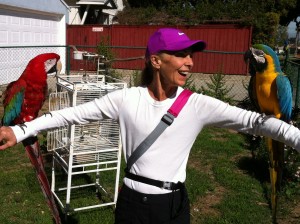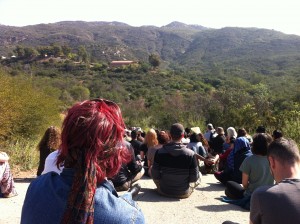It was November 25, 2015, day four of a seven-day silent meditation retreat.
Forty of us sit in the dusk-lit meditation hall at the retreat center. Gil suggests that before we go to bed, we set an intention for the next day. Without hesitation, I set an intention to let go of all expectations and control.
During a guided meditation the next day, I sit cross-legged on a zafu and zabutan, hands on knees, eyes closed, and observe myself sitting on the edge of time and space…defying physics in the spacious consciousness of freedom from the internal chatter, body tension, and learned expectations of what being human is supposed to be. I had let go.
When I try putting words to this experience, it sounds like: I was sitting on a line. No. A line has distance and distance means time. I was sitting on a point. How could I fit on a point? I was sitting on now. You know, that elusive place. Now is not even ephemeral. Here. Gone. Like that. Teetering in the moment between past and future. Now.
Reaffirming the intention
On December 31, 2015 at a meditation center in Santa Monica, I reaffirm my intention…this time I extend it to this year. My intention is to let go of all expectations and control, and add, “My intention is to [fuzzy memory]” something about being my authentic self and doing work that is meaningful to me.
None of this seems odd or outlandish. The way I’ve been living…with expectations, the illusion of control, and not enough courage to be my authentic self…has led to disappointments, a feeling of failure, self-criticism (i.e.: labeling experience as failure), self-doubt, self-loathing, and body tension I wasn’t aware of. I reached a tipping point…old habits weren’t working anymore.
Since then, I am letting go of all expectations and control has become a kind of mantra for me. And with that, my experience of life is changing.
We’re all in this boat
I share this with you because I believe most of us learn to have expectations about what life is supposed to be. We learn all the rules, the shoulds, the striving, the clinging. We learn that owning a house, a car or two, working in a cubicle in a building, getting married, having children…pursuing a career that earns enough money to afford all of that, is what life is. We learn to worry about the future and ruminate about the past.
When @$!& happens as it did in 2008, when illness or accidents happen, when unfortunate events happen, when this version of life becomes too much, some of us let go. If we’re unlucky, we escape into unhealthy habits…with awareness, we can let go…
like Neo did with intention and unplug from The Matrix.
Observations
This brings me to the past week’s unexpected encounters. As you visit these memories with me, keep in mind the intention. No expectations. No control.
While walking to the mindfulness group I lead on Wednesdays in Manhattan Beach, I realized I had gone too far and had to loop back along the railroad tracks to get to the street that leads to 2nd, my usual route. And there out in their front yard of a house I would not have passed were Keith and his two parrots.
 Keith was spraying their feathers with water. He said the water keeps their feathers healthy, shiny. We talked for a while then he asked me if I wanted a picture with them. We talked some more and then I went on my way. Now I know Keith and his parrots. I wished him a motorcycle ride…he hasn’t been riding for a while.
Keith was spraying their feathers with water. He said the water keeps their feathers healthy, shiny. We talked for a while then he asked me if I wanted a picture with them. We talked some more and then I went on my way. Now I know Keith and his parrots. I wished him a motorcycle ride…he hasn’t been riding for a while.
Two new people came to the mindfulness group. Turns out they had heard about it from someone I don’t know.
I stopped at Trader Joe’s on my walk home. A young, lanky, Asian man [unusual even for TJs] was stocking the dairy section with individual-sized containers of yogurt…using a putting iron! I laughed; so did he.
“It’s version 2.0,” he said, and showed me how someone had cut off the head of the iron and bent the shaft. He was using it to line up the containers in rows with the least space between them.
Then, at the cash register, another man, young, attractive, kind face, held a jar of olive tapenade while I went back to the dairy case for a bottle of green cold pressed juice like the one he was buying. We agreed that it was good to run into each other…just because.
These chance encounters happen every day now. As my body softens; as my heart opens; as I let go of all expectations and control…
Softening invites in kindness
One of my other teachers mentioned this might happen. Matthew was giving a talk on kindness and was explaining how softening the body opens us to kindness.
Soft, open, and vulnerable are not words we hear often. Pump iron, build muscle, have snappy comebacks on Facebook, protect yourself, be strong…even yoga can be a strength-building exercise! We learn to build tension, armor, walls to keep out the risk of being hurt or left behind or left out.
Tense body
Throughout each day and night, we are bombarded with stimuli from outside and inside us. Noise, light, movement, pressure, smells, temperature changes, visuals, thoughts, feelings, memories…all coming at us at speeds we can’t control. Your conscious mind may not be aware of this, but your unconscious mind and body are. The body holds tension that we learn to accept as normal.
What can we do
We can practice becoming aware of the tension, aware of our expectations, aware of this illusion of control. And then we can practice letting go. Each time we let go of a little of it. A little body tension. A troubling thought. A worry. An expectation. The illusion of control. Each time, we soften and open to the world, we invite in kindness.
I can run again…not far or often, but far enough and often enough. I can get into yoga poses that were impossible for me before. I feel softer, more open, and yes, more vulnerable. Being open and vulnerable means being open to kindness and also open to hurt, pain, loss, and real reality. It’s all part of life.
Don’t believe Gil or Matthew or even me, though. Try if for yourself. Let go for a breath. And see what happens.

